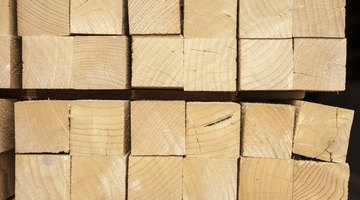6-by-6 Wood Strengths
Table of Contents
Six-by-six lumber actually has 5 1/2-by-5 1/2-inch dimensions. Wood this size is typically referred to as a beam, post, girder, timber or structural lumber. A large majority of structural timber is made from Douglas fir, hemlock and spruce.

Although species is somewhat important, it's typically not the deciding factor regarding wood strength. The condition, seasoning, milling and grading per industry standards are what you need to look for when selecting 6-by-6 lumber.
Wood Strength by Type
Six-by-six beams can be milled from almost any wood species, but only a handful of commonly milled species are readily available. Douglas fir is one of the most widely-used and strongest wood species commonly used for six-by-six lumber, sometimes marketed as hem-fir or fir-larch, because of its close association with hemlock and larch. Spruce runs a close second with respect to wood strength. Less available species in this lumber size such as oak, is actually rated stronger than fir or spruce, but hard to find and expensive. The least strongest six-by-six posts are varieties of western pine.
Grain Strength
One of the determining characteristics of strong timber is its grain patterns. Douglas fir and spruce have consistent, straight grain. Forces that determine the strength are typically applied to the wood parallel with the grain -- or end to end. Wood strength is optimum when grain lines are straight. When grain lines wander or curve, they can cause the wood to shear off or break when pressure is applied to either end.
Lumber Stamps
The American Society for Testing and Materials -- known as ASTM -- established the standards that regulate lumber strength. Look for stamps on lumber that identify its status under these standards. If the wood has a "KD" stamp on it, for example, that means that the wood has been kiln dried to a specific level for strength. Other stamps indicate wood grade, species, flame retardation, origination or mill location. The strongest 6-by-6 posts display stamps indicating wood strength and quality.
Clear is Best
Characteristics effecting strength are more important than wood type -- even if the wood has been previously stamped. Six-by-six posts exhibit a wide range of strength in regard to knots, cracks, holes and splits. The strongest six-by-six of any species might be marketed or stamped as "clear" meaning the lumber post has no defects.
Circular Patterns
Circular growth patterns converging in the center of the post indicate the lumber was cut from the heartwood of the tree. Posts cut from the center of the tree are stronger than posts without a centered grain pattern. To check for heartwood look at the end of the post. The closer the concentric pattern is to the center of the post, the stronger the 6-by-6. The higher the density of circles per inch, the stronger the wood.
The Drip Cap
- Six-by-six lumber actually has 5 1/2-by-5 1/2-inch dimensions.
- Less available species in this lumber size such as oak, is actually rated stronger than fir or spruce, but hard to find and expensive.
- Douglas fir and spruce have consistent, straight grain.
- Other stamps indicate wood grade, species, flame retardation, origination or mill location.
- ** The strongest six-by-six of any species might be marketed or stamped as "clear" meaning the lumber post has no defects.
- ** The closer the concentric pattern is to the center of the post, the stronger the 6-by-6.
References
Resources
Writer Bio
Specializing in hardwood furniture, trim carpentry, cabinets, home improvement and architectural millwork, Wade Shaddy has worked in homebuilding since 1972. Shaddy has also worked as a newspaper reporter and writer, and as a contributing writer for Bicycling Magazine. Shaddy began publishing in various magazines in 1992, and published a novel, “Dark Canyon,” in 2008.
Photo Credits
- SlobodanMiljevic/iStock/Getty Images
- SlobodanMiljevic/iStock/Getty Images
More Articles



